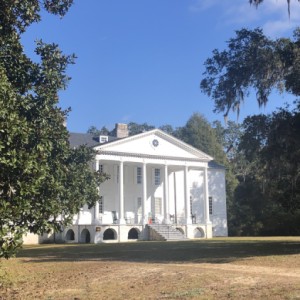St. James Santee And the Brick Church of Wambaw
We stopped to visit Hampton Plantation State Historic Site on the way home today. We saw a sign as we were coming back out to the main highway for St James Santee church so of course we are thinking old church in the woods. We turned on the sandy pothole filled road and drove about four or five miles in the forest when we finally found the church. There was nothing else on this road except one house near the church which we think may be the caretakers house.
What a great history lesson we had today. This is the information that I found about this old church.
" In January 1687 a group of French Protestant (Huguenot) immigrants ventured up the Santee River and found a 30 foot high limestone bluff where they sheltered beneath a sail until they could construct a more substantial building “in the Carolina fashion.” They called their settlement Jamestown and began selecting sites for plantations up and down the river. They were joined by other French refuges who had fled persecution, forced abjuration of their faith and sometimes death in their native land. The area became known as French Santee. Of primary importance to them was the establishment of a place of worship and they set aside a strip of land on the bluff overlooking the river for their church and
graveyard.
On April 9, 1706, St. James-Santee was chartered as a parish of the Church of England –a parish being the primary geo-political and ecclesiastical unit of the colony. It was the first parish created outside of the city of Charles Towne in Carolina. The Parish of St James Santee extended from Awendaw Creek to the Santee River.
There have been at least five church buildings in the Parish since 1687. The first was located in Jamestown on the Santee River before 1706 and served the roughly one hundred Huguenot settlers. Before 1714 the congregation had built a small chapel on the southeast bank of Echaw Creek for the rapidly expanding eastern portion of the parish and that year a new Chapel of Ease was ordered to be built. It was replaced with a third chapel on Echaw Creek, this time of brick in 1748. The next building, built in 1768 on the King’s Highway, was called Wambaw Church after the nearby creek and is now known locally as Old Brick Church. The building now used every Sunday by the congregation was built in McClellanville in 1890 as a Chapel of Ease for Wambaw Church. The location of the buildings followed the moving population.
About the Brick Church at Wambaw
Although Wambaw Church stands alone on the old King’s Highway among the pines and oaks of the forest, it was once the center of a busy and prosperous community. North and south along the Santee River were rice plantations whose Carolina rice became famous all over the world and the prosperity of the planters is reflected in the beauty and proportions of Wambaw Church. The body of the church was built of brick imported from England, but the columns of the portico were constructed of local wedge-shaped bricks. The pews were made of hand-pegged cypress, the flagstone floor has withstood the ravages of two wars and the vaulted ceiling still retains the original plaster work.
The building had identical porticos until 1852 when the north one was enclosed to form a vestry room. The Palladian window on the east marks the original chancel which was moved to its present location after the Civil War. Although the pews were removed at that time, they were not damaged and the church was closed until it could be repaired.
By 1768 when St. James Santee's Wambaw Church was built, many descendants of the original French refugees had intermarried with English settlers. St. James Santee, though, has always been closely associated with the Huguenot immigrants who first settled the area and has been known variously as “The French Church” and as the “church of the Huguenots.”
Wambaw Church did not escape the desolation characteristic of most of the South after the Civil War. By 1877 the majority of the congregation (only 13 families at that time) had relocated to the village of McClellanville and, once the Chapel of Ease *(see explanation of a chapel of ease below)* in the Village was built, only occasional services were held in the “old Brick Church.” By 1918 an annual service was being held by the congregation who still welcome friends and relatives the Sunday after Easter for an 11 am service followed by a covered dish picnic in the graveyard.
Between the 1920’s and the early 1970’s, various fund-raising efforts were aimed at stabilizing and preserving Brick Church. In 1972 it was designated a National Historic Landmark and restoration efforts took on a new momentum. In 1994, the Church Restoration Committee was formed and met for the first time that April. Since that time, the preservation and restoration of Brick Church has continued at a brisk pace.
Today, the Brick Church at Wambaw is valued not only for its architectural and historical significance, but also as a spiritual home for those whose ancestors encountered in it “a mighty refuge.”
Chapel of Ease.... a chapel situated for the convenience of parishioners living a long distance from the parish church. The town of McClellanville is about 10 miles from the location of this old church so it was a long trip by horse and buggy to the church.
Always take the dirt roads!!! The Hampton Plantation on Wambaw Creek is in the extras. It was a good history lesson also.


Comments
Sign in or get an account to comment.


